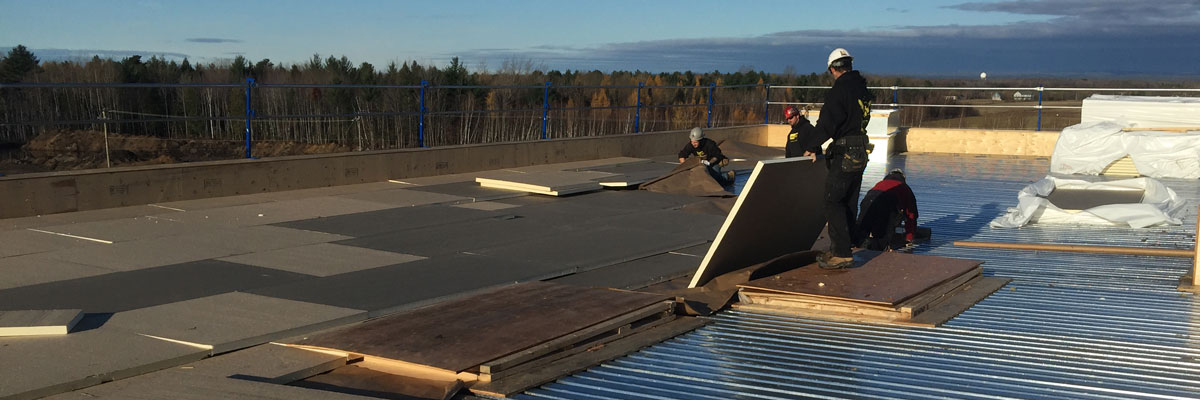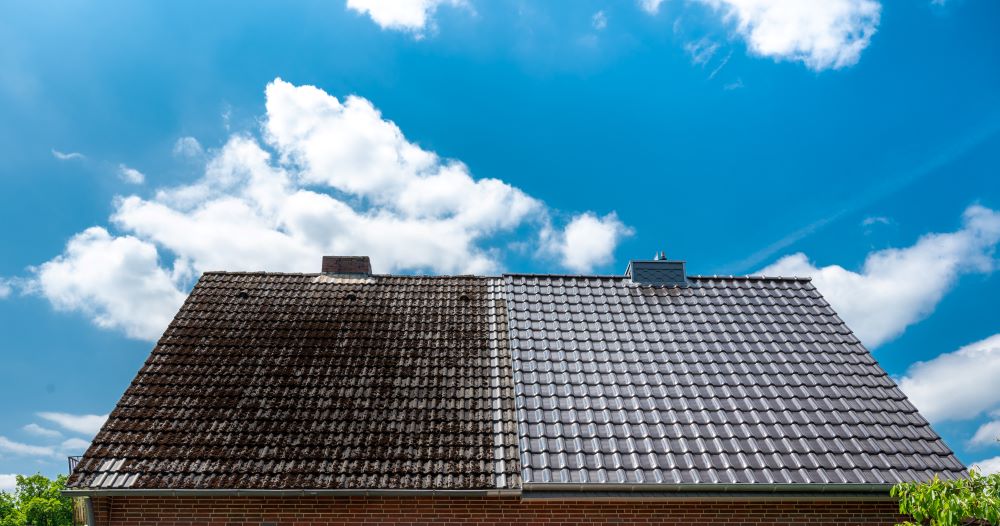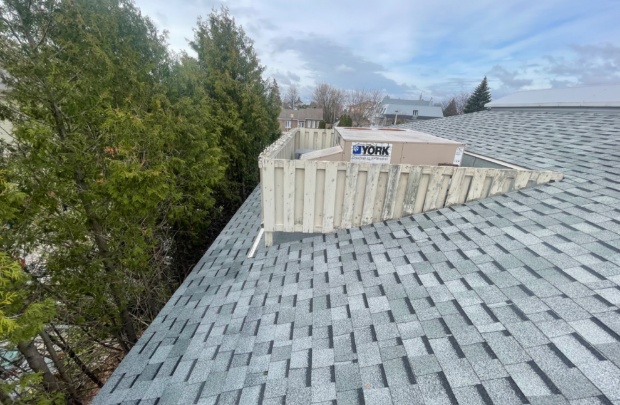More than just a symbol of protection and comfort, the roof of any building requires special attention if you want it to do its job well. Especially if you have an old roof that has withstood the elements for many years, it may be time to consider a restoration.
A well-maintained roof can significantly improve the energy efficiency of your building. However, roof restoration requires careful planning and deliberate, step-by-step execution to be successful.
In this article, the experts at our Montreal roofing company guide you through the entire roof restoration process and offer valuable advice on deciding when to restore your roof, which steps to follow to complete the project successfully, and how much roof restoration could cost.
When is it time to restore your roof?
Before beginning a roof restoration, you need to decide whether your roof really needs to be renovated (or replaced). There are many signs that could indicate your roof needs work, and it’s important to note these early and take action to prevent more serious problems in the future.
Signs your roof needs restoration
- Water leaks and seepage: If you notice water stains on the ceilings or walls of your home, this may be caused by a leaky roof. Water infiltration can damage the structure, insulation and other components of your building. This is a sign that your roof needs immediate attention.
- Broken or missing shingles: Broken or missing tiles, shingles or other roofing materials are clear signs that your roof needs a restoration. Gaps in the roofing cover can allow water to penetrate the building and cause damage.
- Deterioration of roofing materials: If you notice signs of wear on your roofing materials, like buckling, cracks or discoloration, it’s time to consider a roof restoration.
- Loss of energy efficiency: If your energy bills are rising for no apparent reason, it could be due to poor insulation. Re-insulation can improve your building’s energy efficiency.
- Advanced age: If your roof has exceeded its normal lifespan (generally between 20 and 30 years, depending on the material), we recommend considering a restoration, even if there are no obvious signs of damage.
The benefits of preventive roof repair
There are several advantages to preventive restoration. By acting before problems worsen, you can save money in the long term and avoid more costly repairs. Preventive restoration can also make your roof more watertight, improve insulation and help preserve the structure of your building.
If you think you need a professional preventive restoration service, contact our roofers!
How to repair an old roof in 8 steps
The process of renovating an old roof requires careful planning and respect for a specific procedure. There are 8 steps to follow to successfully repair your roof.
1. Assessment of current roof condition
Before starting any work, you need to carry out a complete assessment of your roof’s current condition. This involves inspecting the framework, roofing materials, flashing and any signs of damage. Identify damaged areas, leaks and signs of deterioration to determine the extent of the work required.
2. Planning and design
Once the assessment is complete, you can start planning the restoration. Choose roofing materials according to the local climate, how you want your building to look, and durability. Remember to consider roof insulation so that you can improve your building’s energy efficiency. Draw up a detailed plan that includes everything from materials to architectural layout.
3. Site preparation
Prepare the site by making the area secure and doing whatever is necessary to protect the immediate surroundings. Install safety barriers and protect windows and exterior fittings to avoid potential damage during the restoration. Make sure you have all necessary equipment.
Since roofing work involves working at heights, it’s best to leave it to a professional. At Duro-Toit, we have the equipment and experience to carry out work at heights in complete safety.
4. Demolition and disposal
The process begins with the removal of old roofing materials, such as tiles or shingles, making sure to respect safety regulations. Remove damaged layers and clean the surface in preparation for the installation of the new roof.
5. Renovation of the roof structure
If your roof structure is showing signs of deterioration, now is the time to make the necessary repairs. Reinforce beams, replace damaged parts and make sure the framework is strong and can safely support the new roof.
6. Insulation and ventilation
Take advantage of this opportunity to improve your sloped roof ventilation and insulation. You can add high-quality insulation material between the rafters to improve the energy efficiency of your home or building. Make sure your roof also has adequate ventilation to prevent moisture build-up.
7. Installation of the new roof
Choose roofing materials that will function correctly for the type of building, and look good too. Whether you opt for traditional shingles, asphalt shingles or other modern materials, be sure to follow installation instructions for a watertight, long-lasting roof.
8. Finishing and inspection
Once the new roof has been installed, you’ll need to do some careful finishing to ensure that it remains watertight. Do a thorough inspection to make sure everything is up to standard and every detail has been looked after.
How much does roof restoration cost?
One of the key elements to consider when restoring your roof is the total cost of the project. Factors influencing cost can vary considerably. The following are the main points to consider:
Factors influencing the cost of roof renovation
- Roof size and shape: The size of your roof is an obvious factor influencing cost. Larger roofs require more materials and labor, which will increase expenses. The complexity of the roof configuration, such as slopes, dormers or chimneys, can also influence the cost of roof restoration.
- Choice of materials: The type of roofing materials you choose plays a role in determining the overall cost. Top-of-the-range materials may be more expensive to buy, but can offer greater durability and look better for a longer time.
- Additional work: If the roof structure needs repairing, insulation needs improving, or items such as rain gutters and vents need replacing, this additional work will add to the overall cost of the restoration project.
- Accessibility and safety: If your roof is difficult to access or workers need to take extra safety precautions to do the job, this can add to the cost. Sometimes it is necessary to take measures protect your property during the work, which could also influence the overall cost.
For a free quote, fill out our form today!
Budget for roof restoration
To estimate the budget for your roof restoration, you can:
- Ask for quotes: Get detailed estimates from several roofing contractors. This will give you a clearer idea of the costs associated with your specific project.
- Calculate the cost of materials: Calculate the approximate cost of materials required, based on the surface area of your roof.
- Include extra costs: Don’t forget to include additional costs such as structural repairs, insulation, vents, rain gutters and finishing.
- Allow a margin: It’s a good idea to allow a margin for unexpected expenses and cost variations. In general, we recommend a margin of 10% to 20% of the total budget.
- Look for grants and financial assistance: Find out about any grants or financial assistance programs available for roof restoration. These initiatives can help reduce your expenses.
Roofing restoration grants in Quebec
If you’re planning to renovate your roof in Quebec, there are several financial assistance programs available to help finance your project. Here’s an overview of the different resources available to help you finance your roofing project.
CMHC Eco Plus
The CMHC Eco Plus program offers subsidies to homeowners who purchase climate-friendly housing. A pre- and post-retrofit energy assessment is required to qualify. Rebates can vary from 15% to 25%, depending on the energy savings achieved by your building.
Rénoclimat
The Rénoclimat program encourages energy-efficient home renovations. For roof insulation work, grants range from $35 to $975, depending on various criteria such as the surface area being insulated and the insulation values before and after the work. Owners of single-family homes, duplexes, triplexes or apartment buildings of up to three storeys and 600 square metres are also eligible.
RénoRégion
The RénoRégion program is aimed at homeowners in rural areas whose dwelling value does not exceed $150,000. It finances up to 95% of the cost of eligible work, to a maximum of $20,000. However, this amount can rise to $25,000 for households with incomes below or equal to the AIL. This program is available in municipalities with fewer than 15,000 inhabitants and in the Gaspésie-Îles-de-la-Madeleine region.
GST and QST rebates
Owners of single-unit buildings or condominiums may be eligible for a GST/QST rebate on major renovations. Eligibility criteria apply, such as occupancy of the residence after the work and the cost of the work.
Renovation Quebec
The Renovation Quebec program is designed to provide financial support to homeowners in run-down residential areas. Eligible projects include home renovations for low-income households and major home renovations.
Municipal programs
Many municipalities in Quebec, including Montreal, offer subsidy programs for roof repairs in specific areas. Amounts and eligibility criteria may vary. For more information, contact your local municipality.
Duro-Toit: roof restoration for every building
Renovating your building’s old roof is the only way to guarantee that it will last a long time and protect the rest of the building. To ensure exceptional results and peace of mind throughout the process, it’s always better to rely on a professional roofing service.
Duro-Toit roofers are experts in flat and pitched roof restoration. We understand the importance of giving attention to every detail during a roof restoration. Our highly trained team has the expertise to assess your roof’s current condition, plan the renovation strategically and carry out each step of the project with precision.
Whether you have a flat or pitched roof, we can provide superior solutions. You can rely on our years of experience to benefit from a high-standard professional job. Contact us to discuss your project!



